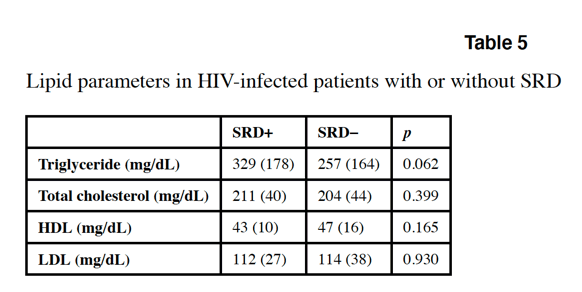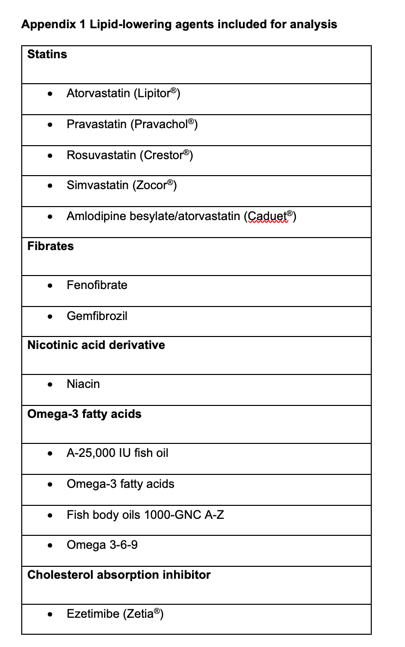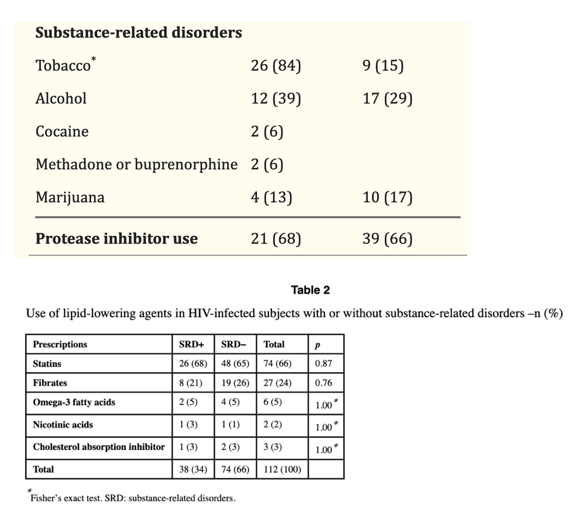| |
Lipid-lowering therapy in HIV-infected patients: relationship with antiretroviral agents and impact of substance-related disorders
|
| |
| |
Download the PDF here
Curr Vasc Pharmacol. 2016, Cindy Bednasz, Barry S. Zingman, Amneris E. Luque, Margaret A. Fischl, Barbara M. Gripshover, Charles S. Venuto, Jie Gu, Zekun Feng, Robin DiFrancesco, Gene D. Morse, and Qing Ma
Translational Pharmacology Research Core, Center of Excellence in Bioinformatics and Life Sciences and School of Pharmacy and Pharmaceutical Sciences, University at Buffalo; Montefiore Medical Center, Albert Einstein College of Medicine, Einstein/Montefiore Center for AIDS Research; University of Miami; Case Western Reserve University/University Hospitals of Cleveland; University of Rochester
Mounting evidence suggests an association between drug abuse and poor glycemic control and diabetes complications. Substance related disorders (SRD) may increase the risk of metabolic syndrome.
While the association between LPV/r and dyslipidemia was implicated in a number of studies, non-nucleoside reverese transcriptase inbhibitors, particularly nevirapine, have demonstrated a more lipid-friendly profile than LPV/r with an HDL increase and a remarkable reduction in total cholesterol/HDL ratio (42).
One Third Lower MI Risk With Atazanavir Than Other ARVs in US Veterans
Substance-related disorders, particularly high cigarett smoking rate, are well estabolished cardiovascular risk factors commonly found in patients with HIV infection. In the present study, the SRD+ group had a remarkably higher percentage of subjects smoking compared to that in the SRD- group (84% vs. 15%, p<0.001). Evidence has revealed that cigarette smoking promoted systemic atherosclerosis by damaging the arterial endothelium, suggesting that smoking might contribute to the pathogenesis of dyslipidemia that requires lipid-lowering medication use (45). As well, a recent national survey has estimated a significantly higher rate of smoking in the SRD positive population than that in the general population (46). Current IDSA guideline recommends smoking cessation regardless of cardiovascular risk due to its multiple adverse effects on metabolism, drug interactions, bone health and cardovascular system (47).
CONCLUSIONS: The study demonstrated a high prevalence of lipid lowering medication use among HIV-infected patients regardless their SRD status. Statins were the mainstay for the lipid management, followed by fibrates. Notably, the majority of SRD+ patients receiving lipid-lowering agents were smokers and on LPV/r-based regimens. This combination could substantially increase the risk of atherosclerosis and cardiovascular complications. The limitations of this study might have precluded statistical significance, however, future studies with a large sample size are warranted to investigate the impact of SRD and cART on development of dyslipidemia as well as lipid management.
Lipid lowering agents were divided into the following classes: statins, fibrates, omega-3 fatty acids, nicotinic acids and cholesterol absorption inhibitors. Although the CURVE study demonstrated atorvastatin 10, 20 and 40 mg produced greater reduction in low-density lipoprotein (LDL) cholesterol at equivalent doses of simvastatin, pravastatin, lovastatin and fluvastatin; cautions should be exercised with atorvastatin and most PI co-administration, except tipranavir, which is contraindicated with atorvastatin use. For co-administration, atorvastatin should be started with a low dose and gradually titrated to higher doses (10). Despite of a favorable drug interaction profile, pravastatin only accounted for 19% prescription likely due to its low efficacy. Pitavastatin has the least potential for drug-drug interactions with PIs, but was not available during the study period (10, 40, 41). Simvastatin is contraindicated with all PIs, but safe with concurrent use of efavirenz.
Statins were the mainstay of dyslipidemia treatment for HIV-infected patients (66%), followed by fibrates (24%), omega-3 fatty acids (5%), nicotinic acid (3%) and the cholesterol absorption inhibitor (3%).
The lipid parameters between SRD+ and SRD- groups were summarized in Table 5. While total cholesterol and LDL appeared to be largely under control with borderline high (∼200 mg/dL) and near optimal (∼110 mg/dL) levels, respectively, for subjects receiving lipid-lowering agents regardless their SRD status, the average triglyceride levels remained high for both groups (>250 mg/dL), particularly among those with SRD (329 mg/dL), suggesting suboptimal triglycerides management with lipid-lowering therapy.
The global HIV epidemic continues to grow, and is associated with substance-related disorders (SRD) (12-16). This underscores the need to develop individualized treatment programs that provide clinical care for both HIV and SRD in an integrated setting (17-26). Although it is well appreciated that cART adherence is important to achieve sustained viral suppression, many clinicians often indicate that this goal is a challenge in patients with SRD due to poor adherence (27-31). In addition, patients with SRD are often perceived to have comorbidities that preclude successful antiretroviral adherence. Disease complexity factors such as co-infection with tuberculosis, malaria, hepatitis B and C, or behavioral health disorders and cancer may influence antiretroviral exposure (32-35). There is evidence that suggests those with a history of drug abuse are more likely to have poor glycemic control and diabetes complications (36, 37). SRD per se may increase the risk of metabolic syndrome (38). This retrospective analysis aims to examine the relationship between SRD, antiretroviral therapy and lipid lowering agent use.
The difference in use of lipid-lowering agents in the SRD+ and SRD- groups is listed in Table 2. Overall, 23% (30/130) of subjects with SRD received statins or fibrates treatment, in comparison to 40% (58/146) without SRD (p=0.005). Statins and fibrates had comparable use within the SRD+ and SRD- groups (statins: 68% vs. 65%, p=0.87, fibrates: 21% vs. 26%, p=0.76). Omega-3 fatty acids, nicotinic acid and cholesterol absorption inhibitor were the least utilized agents and did not show a statistical difference between the two groups. Twenty one percent (21%) of subjects (19/90) used combination lipid-lowering agents.

Statins were the mainstay of dyslipidemia treatment for HIV-infected patients (66%), followed by fibrates (24%), omega-3 fatty acids (5%), nicotinic acid (3%) and the cholesterol absorption inhibitor (3%). Atorvastatin was the most frequently prescribed statin in both the SRD+ and SRD- groups, followed by pravastatin (Figure 1); with fenofibrate being the most commonly prescribed fibrate (Figure 2). When looking at interactions between utilization patterns of antiretrovirals and lipid lowering agents within the SRD+ group, there was a comparable trend of statin use in the ATV, LPV/r, and EFV groups and comparable fibrate use in all four groups (Table 3). While 30% of patients (58/193) on PI-based antiretroviral regimen received statins or fibrates, 36% on EFV (26/73) required either statin or fibrate containing lipid lowering treatment (p=0.141). In the SRD- group, LPV/r group had the greatest number of statins users, followed by EFV, other-protease inhibitors, and ATV (Table 3). No difference was noted between PI-based and efavirenz-based regimens in the use of statins and fibrates (89% vs. 91%, respectively, p=1.00). Fibrates were mostly used in the ATV group, with comparable use between the remaining groups. Comparing the use of antiretrovirals between the SRD+ and SRD- groups, a significant difference was noted in the use of LPV/r between the SRD+ and SRD- groups (25 vs. 8%, p=0.02) (Table 4).
Pitavastatin was not included in this list comprised in 2017, the publication date.

Abstract
BACKGROUND
The use of combination antiretroviral therapy (cART) has significantly decreased the morbidity and mortality associated with HIV infection. Lipid disorders, including lipodystrophy, hypertriglyceridemia, hypercholesterolemia, and dyslipidemia, remain the most commonly reported metabolic disorders among those treated with long-term cART. Mounting evidence suggests an association between drug abuse and poor glycemic control and diabetes complications. Substance related disorders (SRD) may increase the risk of metabolic syndrome.
MATERIALS AND METHODS
The aim of this retrospective cohort study was to examine the relationship between SRD, cART, and lipid-lowering agent use in an HIV infected population. A total of 276 subjects with HIV infection were included, 90 (33%) received lipid-lowering agents, and 31 (34%) had SRD. Patients received efavirenz or protease inhibitor-based cART for at least 6 months. Prescription information was retrieved from the medical records. The primary outcome was the use of lipid-lowering agents including statins, fibrates and fish oil. The impact of SRD and cART was assessed on the lipid-lowering agent use.
This was a retrospective cohort study that examined 276 subjects from four HIV treatment and research centers including Bronx, New York; Rochester, New York; Miami, Florida and Cleveland, Ohio.
RESULTS
age 44. Smoking was prevalent among subjects with SRD (84% vs. 15%, p<0.001). Statins were the mainstay for the management of dyslipidemia (66%), followed by the fibrates (24%), omega-3 fatty acids (5%), nicotinic acid (3%) and the cholesterol absorption inhibitors (3%). Use of statins or fibrates was significantly higher among subjects without SRD than those with (40% vs. 23%, p=0.005). The type of cART, including efavirenz and protease inhibitors, appeared to have no significant impact on the use pattern of lipid-lowering agents. Lopinavir/r was mostly prescribed for subjects with SRD (25% vs. 8%, p=0.02).
CONCLUSIONS
Among HIV-infected patients, statins remain the mainstay for the management of dyslipidemia in routine clinical care, followed by fibrates. A significant high risk of metabolic disorders among patients with SRD is implicated by heavy tobacco use and prevalent lopinavir/r-based treatment. Significantly low rate of lipid-lowering agent use in this population underscores the importance of lipid disorder scrutiny and cART treatment optimization for HIV-infected patients with SRD.
Keywords: substance-related disorders, HIV, metabolic disorder, dyslipidemia, lipid-lowering therapy, statins, fibrates
Data from 90 subjects, 33% of 276 total enrollment in the study, between 2003 and 2007 was retrospectively evaluated from 4 different HIV treatment and research centers for use of lipid-lowering agent prescriptions. Overall, 34% (n=31) of the subjects were SRD+. Approximately 25% of the subject population were female, and the majority of subjects were African Americans (32%), Caucasians (32%) and Hispanics (32%). A significant difference was found in smoking status between the SRD+ and SRD- groups (84% vs. 15%, respectively, p<0.001). The demographic characteristics of the study population are summarized in Table 1.

|
|
| |
| |
|
|
|